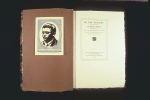
The Artists of the Oriole Press Ishill was a collector of graphic arts materials, and his personal library contained a large number of publications related to the graphic arts--which he eventually donated to the University of Florida- Gainesville Libraries. His interest in the graphic arts brought him into contact with several prominent artists who contributed work to his publications. The artist whose work is most often associated with the Oriole Press is Louis Moreau (1883-?), the French wood-engraver. It was Moreau who designed Ishill's printer's mark, and he contributed a large number of woodcuts for Ishill's publications. Another favorite of Ishill was John Buckland-Wright (1897-1954), an American wood- engraver.

Announcement. Elisée and Elie Reclus. Berkeley Heights, N.J.: Oriole Press, 1927.
Garamond and Cloister Oldstyle types with a woodcut by Louis Moreau and initial by Maurice Duvalet; printed in black, red and blue on woodcut paper; 6 x 8.5 inches; 4 p.
Often when Ishill was offering a book for sale, he printed a small announcement sheet such as this one. The following statement appears on the verso: "The Oriole Press will not grind out its books upon the commercial hurdy-gurdy of popular tendencies, for selfish or material purposes," which describes, in a nutshell, the publisher's philosophy. The woodcut by Moreau is reproduced from the book.
To The Toilers And Other Verses, by Basil Dahl (Joseph Bovshover). Berkeley Heights, N.J.: Oriole Press, 1928. Copy no. 3.
Garamond Type; frontispiece drawing by Louis Moreau; printed in black and red; on Roma paper; boards with buckram spine; 6.5 x 9.5 inches; xxiii, 57 p.
Basil Dahl (1873-1915), born Joseph Bovshover, was a Russian emigr;eacute; and a poet whose works often appeared in Benjamin Tucker's anarchist journal Liberty. Ishill tells us that Dahl was "one of the First poets in America who championed the cause of the downtrodden proleteriat," which made him a perfect author for Ishill's Oriole Press. This volume is one of only ten which were printed on hand-made Italian "Roma" paper.
Plant Physiognomies, by Elie Reclus. Berkeley Heights, N.J.: Oriole Press, 1931.
Cromwell and Eve types; frontispiece portrait from an unpublished photograph; wood- engravings by Louis Moreau; printed in three colors; 150 copies on woodcut paper and 50 copies on Strathmore Alexandra Japan vellum; boards with linen spine; 6.25 x 8.25 inches; xxi, 134 p.
Elie Reclus (1827-1904) studied theology before becoming an anthropologist. The older brother of Elis e (1830-1905), the well-known French geographer and philosophical anarchist, he wrote on a great many subjects, including religion and anthropology. In the introduction to this volume Reclus notes, "I am not, I confess, either botanist or gardener. Here then are the impressions produced upon my spirit by some of the amiable creatures of the plant world." The wood- engravings are by Moreau.
The Song Of Songs, As A Drama, by Ernest Renan. Berkeley Heights, N.J.: Oriole Press, 1932. Copy no. 69.
Garamond and Eve types; woodcuts by Louis Moreau; printed in three colors; 100 copies on woodcut paper, 50 on French mould-made, and six on English Maidstone handmade; boards with buckram spine; 6.5 x 9.5 inches; xvii, 30 p.
Renan (1823-1892) was a renowned historian and critic. After studying for the priesthood, he rejected the church and became a Professor of Hebrew. Following the publication of The Life of Jesus (La Vie de Jésus), which suggested that Jesus was not divine, his chair at the Collège de France was suppressed due to the controversial nature of the work. This drama of the story of Solomon is rendered with several woodcuts by Moreau.
Yew-Leaf and Lotus-Petal: Sonnets, by John Evelyn Barlas. Berkeley Heights, N.J.: Oriole Press, 1935. Copy no. 53.
Cromwell and Unziale Hammerschrift types; printed in black and red; nine wood- engravings by John Buckland-Wright; 130 copies on Zerkall Leipzip paper, 10 on Japanese vellum; boards with parchment spine; 5.25 x 7.75 inches; 56 p.
"Certainly no poet ever worshipped his muse more faithfully than Barlas did," says Henry S. Salt (1851-1939) in his introduction. Barlas (1860-1914) was a British poet of minor distinction, in part due to the limited distribution which his poetry received. He was a teacher at Chelmsford Grammar School until his radical beliefs--he was a fol-lower of William Morris and an exponent of socialism--led to his dismissal. These sonnets are illustrated with wood engravings by John Buckland-Wright.
Muted Voices (Glasuri In Surdina), by Eugene Relgis. Berkeley Heights, N.J.: Oriole Press, 1938.
Cromwell type; woodcuts by Louis Moreau; printed in black and green; 500 copies; boards with linen spine; 5.25 x 7.75 inches; 200 p.
Inscription: "for - Agnes, with the cordial greetings of the season - from The Ishills, Dec. 1938." Relgis, a famous Rumanian anarchist, was an author of some distinction, both in Eastern Europe and in South America, his adopted homeland. His work Principles of Humanism was published in translation in eighteen different languages, including an edition by Ishill. In his introduction to this translation, Stefan Zweig, the renowned German novelist, says, "The book is addressed to those who are able to hear when the tragic and the obscure assume a universal value through the profoundly humanitarian sentiments of the author." Woodcuts by Moreau.